Mixed Matrix Membrane Tip Extraction Coupled with UPLC–MS/MS for the Monitoring of Nonsteroidal Anti-Inflammatory Drugs in Water Samples
Abstract
1. Introduction
2. Materials and Methods
3. Results and Discussion
3.1. Extraction Device Characterization
3.2. Optimization of Extraction Conditions
3.3. Evaluation of Analytical Performance
4. Conclusions
Supplementary Materials
Author Contributions
Funding
Conflicts of Interest
References
- Souza-Silva, É.A.; Reyes-Garcés, N.; Gómez-Ríos, G.A.; Boyacı, E.; Bojko, B.; Pawliszyn, J. A critical review of the state of the art of solid-phase microextraction of complex matrices iii. Bioanalytical and clinical applications. TrAC-Trend Anal. Chem. 2015, 71, 249–264. [Google Scholar] [CrossRef]
- Boyacı, E.; Rodríguez-Lafuente, Á.; Gorynski, K.; Mirnaghi, F.; Souza-Silva, É.A.; Hein, D.; Pawliszyn, J. Sample preparation with solid phase microextraction and exhaustive extraction approaches: Comparison for challenging cases. Anal. Chim. Acta 2015, 873, 14–30. [Google Scholar] [CrossRef] [PubMed]
- Kataoka, H.; Ishizaki, A.; Saito, K. Recent progress in solid-phase microextraction and its pharmaceutical and biomedical applications. Anal. Methods 2016, 8, 5773–5788. [Google Scholar] [CrossRef]
- Basheer, C.; Alnedhary, A.A.; Rao, B.S.M.; Valliyaveettil, S.; Lee, H.K. Development and application of porous membrane-protected carbon nanotube micro-solid-phase extraction combined with gas chromatography/mass spectrometry. Anal. Chem. 2006, 78, 2853–2858. [Google Scholar] [CrossRef]
- Naing, N.N.; Li, S.F.Y.; Lee, H.K. Micro-solid phase extraction followed by thermal extraction coupled with gas chromatography-mass selective detector for the determination of polybrominated diphenyl ethers in water. J. Chromatogr. A 2016, 1458, 25–34. [Google Scholar] [CrossRef]
- See, H.H.; Marsin Sanagi, M.; Ibrahim, W.A.W.; Naim, A.A. Determination of triazine herbicides using membrane-protected carbon nanotubes solid phase membrane tip extraction prior to micro-liquid chromatography. J. Chromatogr. A 2010, 1217, 1767–1772. [Google Scholar] [CrossRef]
- Kamaruzaman, S.; Sanagi, M.M.; Endud, S.; Wan Ibrahim, W.A.; Yahaya, N. Mcm-41 solid phase membrane tip extraction combined with liquid chromatography for the determination of non-steroidal anti-inflammatory drugs in human urine. J. Chromatogr. B 2013, 940, 59–65. [Google Scholar] [CrossRef]
- David, F.; Ochiai, N.; Sandra, P. Two decades of stir bar sorptive extraction: A retrospective and future outlook. TrAC-Trend Anal. Chem. 2019, 112, 102–111. [Google Scholar] [CrossRef]
- Bruheim, I.; Liu, X.; Pawliszyn, J. Thin-film microextraction. Anal. Chem. 2003, 75, 1002–1010. [Google Scholar] [CrossRef]
- Grandy, J.J.; Boyacı, E.; Pawliszyn, J. Development of a carbon mesh supported thin film microextraction membrane as a means to lower the detection limits of benchtop and portable gc/ms instrumentation. Anal. Chem. 2016, 88, 1760–1767. [Google Scholar] [CrossRef]
- Moein, M.M.; Abdel-Rehim, A.; Abdel-Rehim, M. Microextraction by packed sorbent (meps). TrAC-Trend Anal. Chem. 2015, 67, 34–44. [Google Scholar] [CrossRef]
- Kamaruzaman, S.; Hauser, P.C.; Sanagi, M.M.; Ibrahim, W.A.W.; Endud, S.; See, H.H. A simple microextraction and preconcentration approach based on a mixed matrix membrane. Anal. Chim. Acta 2013, 783, 24–30. [Google Scholar] [CrossRef] [PubMed]
- Mukhtar, N.H.; See, H.H. Carbonaceous nanomaterials immobilised mixed matrix membrane microextraction for the determination of polycyclic aromatic hydrocarbons in sewage pond water samples. Anal. Chim. Acta 2016, 931, 57–63. [Google Scholar] [CrossRef] [PubMed]
- Mukhtar, N.H.; Mamat, N.A.; See, H.H. Monitoring of tobramycin in human plasma via mixed matrix membrane extraction prior to capillary electrophoresis with contactless conductivity detection. J. Pharmaceut. Biomed. Anal. 2018, 158, 184–188. [Google Scholar] [CrossRef]
- Riasat Harami, H.; Riazi Fini, F.; Rezakazemi, M.; Shirazian, S. Sorption in mixed matrix membranes: Experimental and molecular dynamic simulation and grand canonical monte carlo method. J. Mol. Liq. 2019, 282, 566–576. [Google Scholar] [CrossRef]
- Ghani, M.; Ghoreishi, S.M.; Azamati, M. Magnesium-aluminum-layered double hydroxide-graphene oxide composite mixed-matrix membrane for the thin-film microextraction of diclofenac in biological fluids. J. Chromatogr. A 2018, 1575, 11–17. [Google Scholar] [CrossRef]
- Rozaini, M.N.H.; Semail, N.-f.; Saad, B.; Kamaruzaman, S.; Abdullah, W.N.; Rahim, N.A.; Miskam, M.; Loh, S.H.; Yahaya, N. Molecularly imprinted silica gel incorporated with agarose polymer matrix as mixed matrix membrane for separation and preconcentration of sulfonamide antibiotics in water samples. Talanta 2019, 199, 522–531. [Google Scholar] [CrossRef]
- Barbosa, M.O.; Moreira, N.F.F.; Ribeiro, A.R.; Pereira, M.F.R.; Silva, A.M.T. Occurrence and removal of organic micropollutants: An overview of the watch list of eu decision 2015/495. Water Res. 2016, 94, 257–279. [Google Scholar] [CrossRef] [PubMed]
- Ji, Y.; Du, Z.X.; Zhang, H.J.; Zhang, Y. Rapid analysis of non-steroidal anti-inflammatory drugs in tap water and drinks by ionic liquid dispersive liquid-liquid microextraction coupled to ultra-high performance supercritical fluid chromatography. Anal. Methods 2014, 6, 7294–7304. [Google Scholar] [CrossRef]
- Sousa, J.C.G.; Ribeiro, A.R.; Barbosa, M.O.; Pereira, M.F.R.; Silva, A.M.T. A review on environmental monitoring of water organic pollutants identified by eu guidelines. J. Hazard. Mater. 2018, 344, 146–162. [Google Scholar] [CrossRef] [PubMed]
- Larsson, E.; al-Hamimi, S.; Jönsson, J.Å. Behaviour of nonsteroidal anti-inflammatory drugs and eight of their metabolites during wastewater treatment studied by hollow fibre liquid phase microextraction and liquid chromatography mass spectrometry. Sci. Total Environ. 2014, 485–486, 300–308. [Google Scholar] [CrossRef] [PubMed]
- Payán, M.R.; López, M.Á.B.; Torres, R.F.; Navarro, M.V.; Mochón, M.C. Electromembrane extraction (eme) and hplc determination of non-steroidal anti-inflammatory drugs (nsaids) in wastewater samples. Talanta 2011, 85, 394–399. [Google Scholar] [CrossRef] [PubMed]
- Mamat, N.A.; See, H.H. Development and evaluation of electromembrane extraction across a hollow polymer inclusion membrane. J. Chromatogr. A 2015, 1406, 34–39. [Google Scholar] [CrossRef] [PubMed]
- See, H.H.; Hauser, P.C. Electro-driven extraction of low levels of lipophilic organic anions and cations across plasticized cellulose triacetate membranes: Effect of the membrane composition. J. Membr. Sci. 2014, 450, 147–152. [Google Scholar] [CrossRef]
- See, H.H.; Stratz, S.; Hauser, P.C. Electro-driven extraction across a polymer inclusion membrane in a flow-through cell. J. Chromatogr. A 2013, 1300, 79–84. [Google Scholar] [CrossRef] [PubMed]
- Padrón, M.E.T.; Ferrera, Z.S.; Rodríguez, J.J.S. Coupling of solid-phase microextraction with micellar desorption and high performance liquid chromatography for the determination of pharmaceutical residues in environmental liquid samples. Biomed. Chromatogr. 2009, 23, 1175–1185. [Google Scholar] [CrossRef]
- Ribeiro, A.R.; Pedrosa, M.; Moreira, N.F.F.; Pereira, M.F.R.; Silva, A.M.T. Environmental friendly method for urban wastewater monitoring of micropollutants defined in the directive 2013/39/eu and decision 2015/495/eu. J. Chromatogr. A 2015, 1418, 140–149. [Google Scholar] [CrossRef] [PubMed]
- Santos, L.H.M.L.M.; Araújo, A.N.; Fachini, A.; Pena, A.; Delerue-Matos, C.; Montenegro, M.C.B.S.M. Ecotoxicological aspects related to the presence of pharmaceuticals in the aquatic environment. J. Hazard. Mater. 2010, 175, 45–95. [Google Scholar] [CrossRef] [PubMed]
- Arous, O.; Kerdjoudj, H.; Seta, P. Comparison of carrier-facilitated silver (i) and copper (ii) ions transport mechanisms in a supported liquid membrane and in a plasticized cellulose triacetate membrane. J. Membr. Sci. 2004, 241, 177–185. [Google Scholar] [CrossRef]
- Mao, X.; He, M.; Chen, B.; Hu, B. Membrane protected c18 coated stir bar sorptive extraction combined with high performance liquid chromatography-ultraviolet detection for the determination of non-steroidal anti-inflammatory drugs in water samples. J. Chromatogr. A 2016, 1472, 27–34. [Google Scholar] [CrossRef] [PubMed]
- Li, N.; Chen, J.; Shi, Y.-P. Magnetic polyethyleneimine functionalized reduced graphene oxide as a novel magnetic sorbent for the separation of polar non-steroidal anti-inflammatory drugs in waters. Talanta 2019, 191, 526–534. [Google Scholar] [CrossRef] [PubMed]
- Wang, R.; Li, W.; Chen, Z. Solid phase microextraction with poly(deep eutectic solvent) monolithic column online coupled to hplc for determination of non-steroidal anti-inflammatory drugs. Anal. Chim. Acta 2018, 1018, 111–118. [Google Scholar] [CrossRef] [PubMed]
- Abd Wahib, S.M.; Wan Ibrahim, W.A.; Sanagi, M.M.; Kamboh, M.A.; Abdul Keyon, A.S. Magnetic sporopollenin-cyanopropyltriethoxysilane-dispersive micro-solid phase extraction coupled with high performance liquid chromatography for the determination of selected non-steroidal anti-inflammatory drugs in water samples. J. Chromatogr. A 2018, 1532, 50–57. [Google Scholar] [CrossRef] [PubMed]
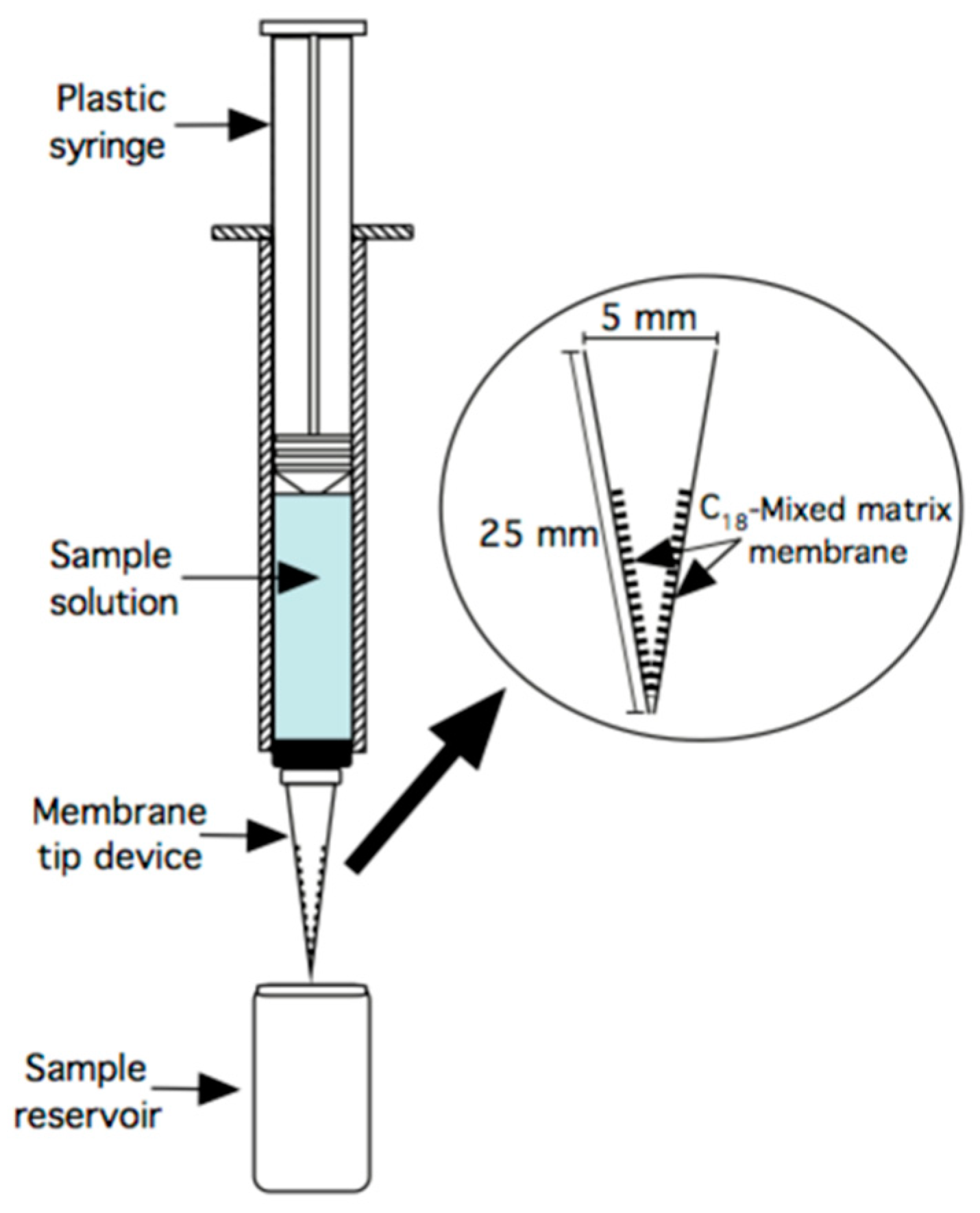
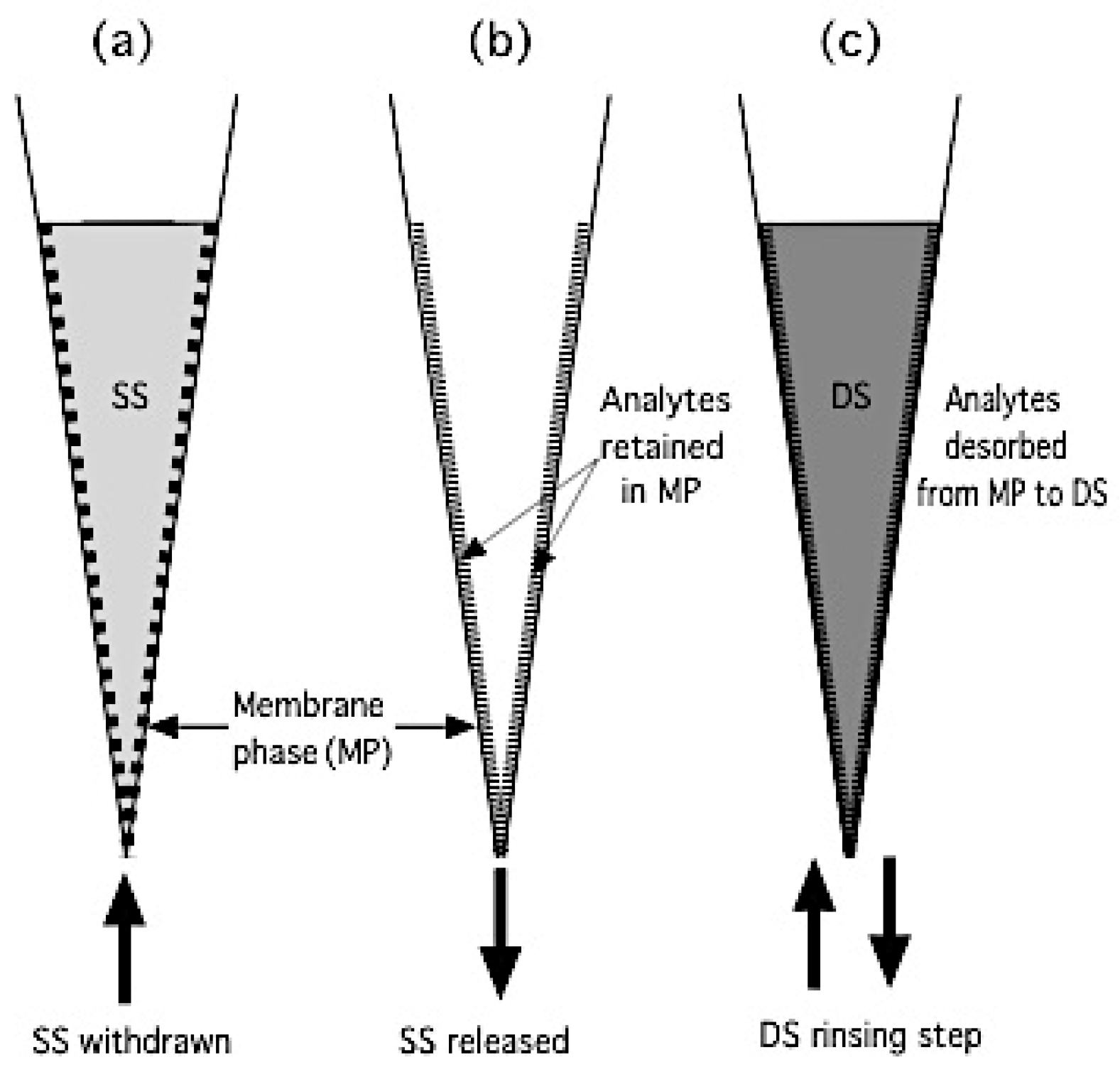
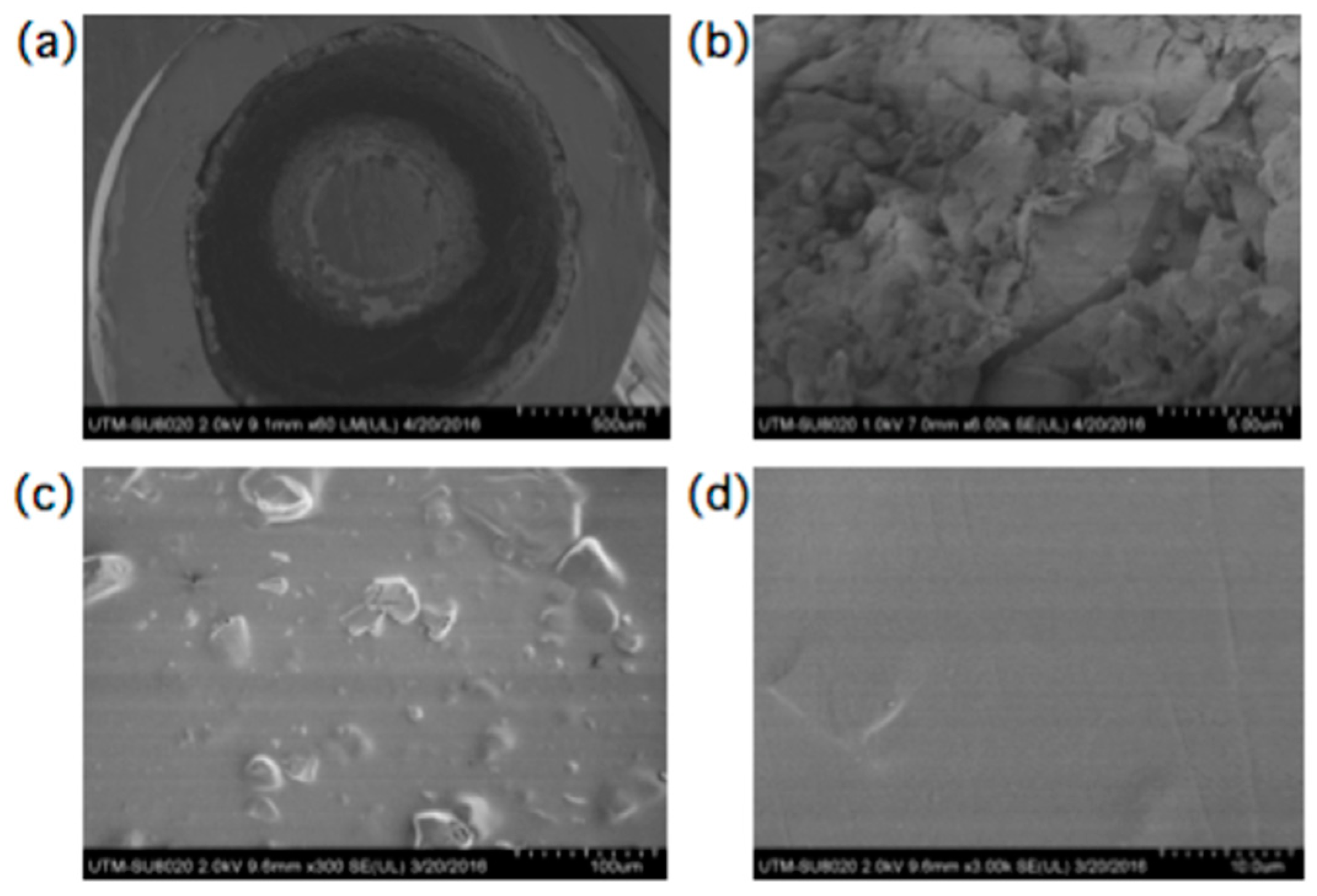
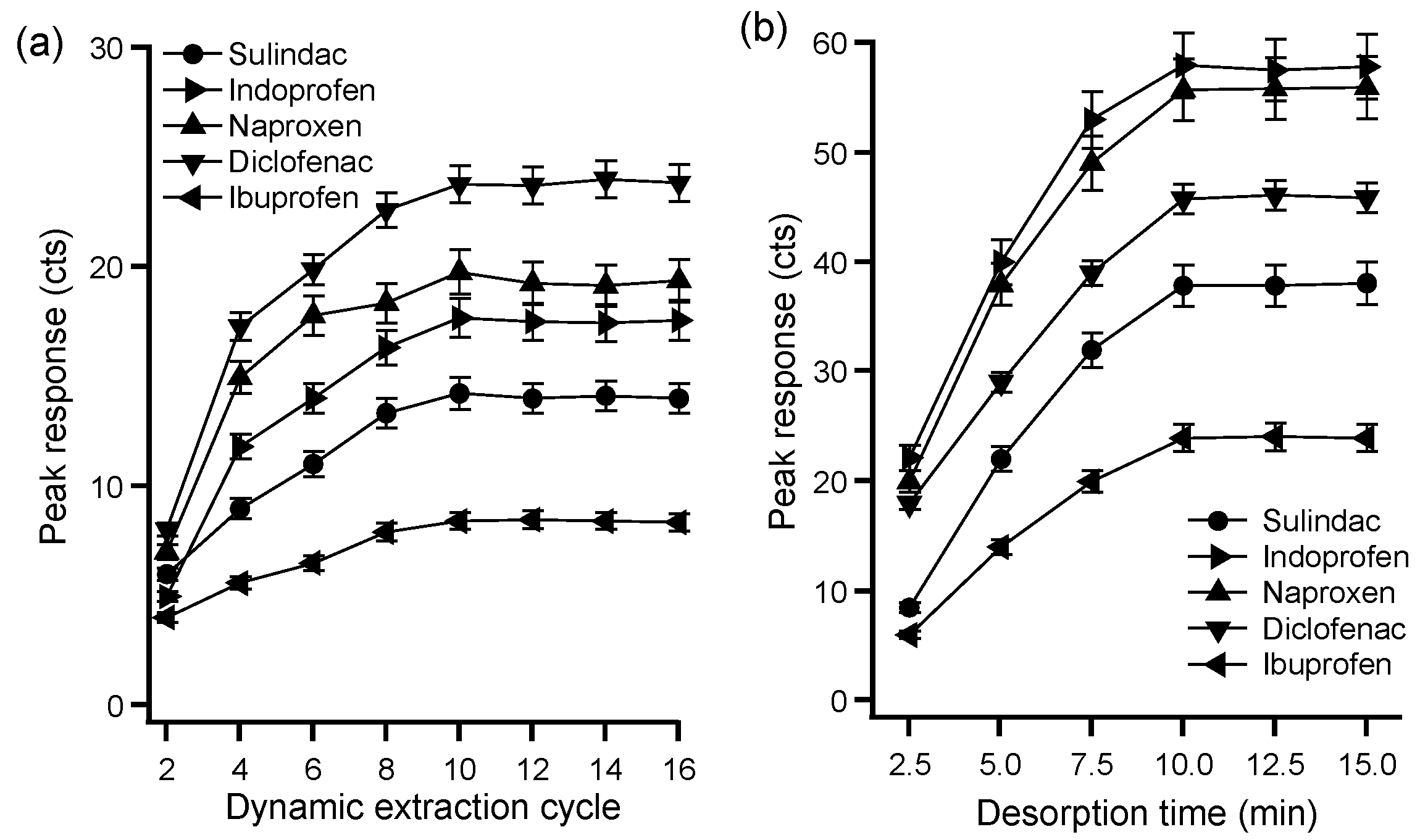
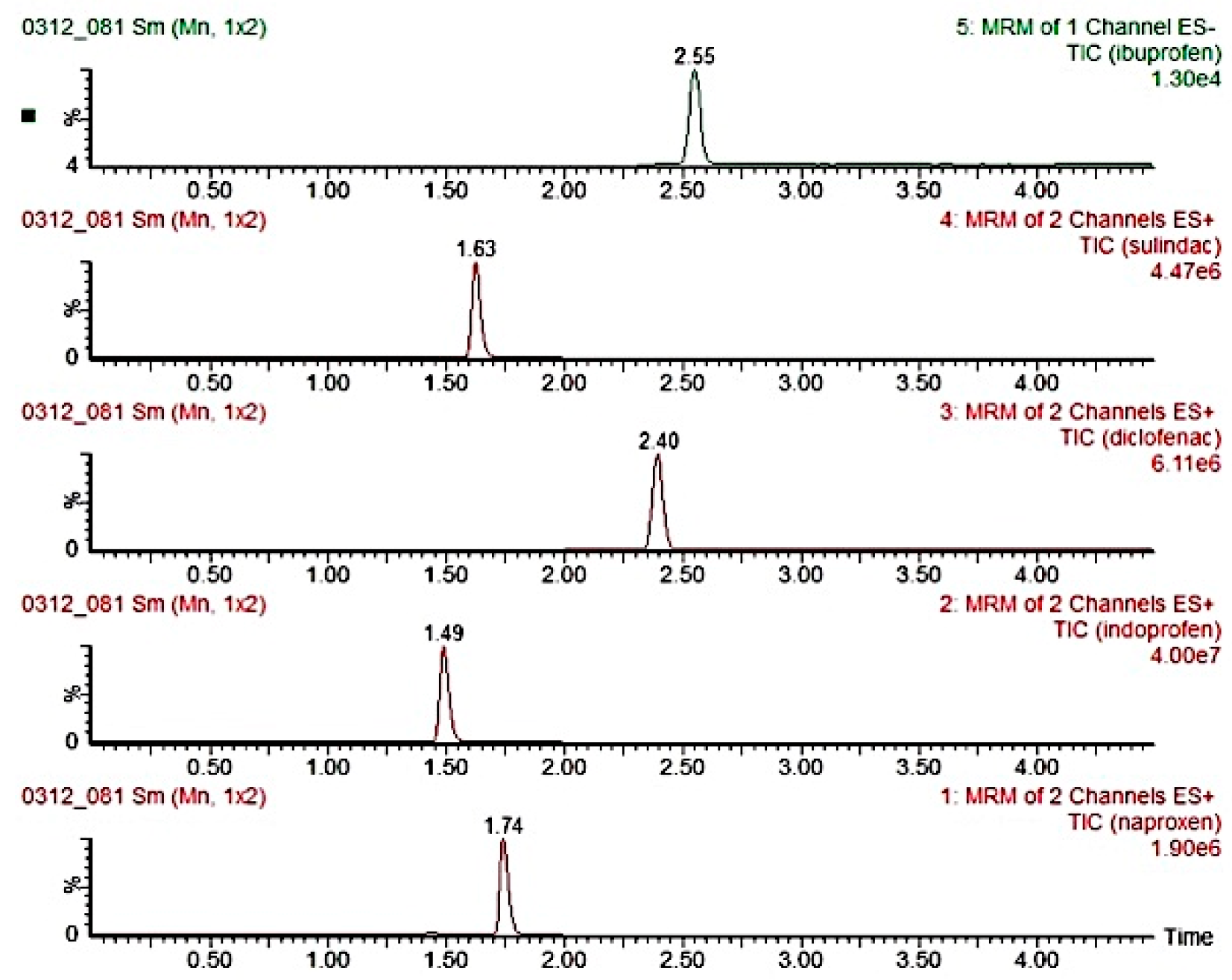
| Analyte | Retention Time (min) | Polarity | Precursor Ion | Product Ion 1 | Product Ion 2 |
|---|---|---|---|---|---|
| Indoprofen | 1.49 | Positive | 282.2 | 77 | 236.1 |
| Sulindac | 1.62 | Positive | 357.1 | 233.1 | 341.1 |
| Naproxen | 1.74 | Positive | 231.1 | 170 | 185.1 |
| Diclofenac | 2.40 | Positive | 296.1 | 215 | 250 |
| Ibuprofen | 2.55 | Negative | 205 | 161.1 | 172.9 |
| Linearity Range (ng L−1) | r2 | LOD 1 (ng L−1) | LOQ 2 (ng L−1) | Repeatability 3, RSD (%, n = 5) | EF 4 | |
|---|---|---|---|---|---|---|
| Indoprofen | 0.25–500 | 0.9992 | 0.08 | 0.25 | 4.3 | 202 |
| Sulindac | 0.30–500 | 0.9988 | 0.10 | 0.30 | 4.6 | 208 |
| Naproxen | 0.50–500 | 0.9990 | 0.15 | 0.50 | 4.5 | 201 |
| Diclofenac | 0.25–500 | 0.9989 | 0.08 | 0.25 | 4.3 | 241 |
| Ibuprofen | 1.30–500 | 0.9990 | 0.40 | 1.30 | 4.9 | 249 |
© 2020 by the authors. Licensee MDPI, Basel, Switzerland. This article is an open access article distributed under the terms and conditions of the Creative Commons Attribution (CC BY) license (http://creativecommons.org/licenses/by/4.0/).
Share and Cite
Ganesan, T.; Mukhtar, N.H.; Lim, H.N.; See, H.H. Mixed Matrix Membrane Tip Extraction Coupled with UPLC–MS/MS for the Monitoring of Nonsteroidal Anti-Inflammatory Drugs in Water Samples. Separations 2020, 7, 19. https://doi.org/10.3390/separations7010019
Ganesan T, Mukhtar NH, Lim HN, See HH. Mixed Matrix Membrane Tip Extraction Coupled with UPLC–MS/MS for the Monitoring of Nonsteroidal Anti-Inflammatory Drugs in Water Samples. Separations. 2020; 7(1):19. https://doi.org/10.3390/separations7010019
Chicago/Turabian StyleGanesan, Thipashini, Nurul Hazirah Mukhtar, Hong Ngee Lim, and Hong Heng See. 2020. "Mixed Matrix Membrane Tip Extraction Coupled with UPLC–MS/MS for the Monitoring of Nonsteroidal Anti-Inflammatory Drugs in Water Samples" Separations 7, no. 1: 19. https://doi.org/10.3390/separations7010019
APA StyleGanesan, T., Mukhtar, N. H., Lim, H. N., & See, H. H. (2020). Mixed Matrix Membrane Tip Extraction Coupled with UPLC–MS/MS for the Monitoring of Nonsteroidal Anti-Inflammatory Drugs in Water Samples. Separations, 7(1), 19. https://doi.org/10.3390/separations7010019






